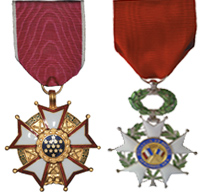
From the Summer 2010 issue of MHQ
Q: I was struck by the similarity between the French Légion d’honneur worn by Napoleon on the cover of your Fall issue and the U.S. Legion of Merit. Is there is a story behind that?
— Francis G. La Piana
Col. U.S. Army (Ret.)
A: The resemblance is no coincidence. When U.S. Army Colonel Robert T. Heard created the original design for the Legion of Merit in 1940, he based it on the French medal because the new award was to recognize foreign military officers—just as the Legion of Honor had been awarded to so many American servicemen in World War I. The badge of both decorations is based on a five-armed enameled cross, each arm having two points tipped with a ball.
Authorized on July 20, 1942, the Legion of Merit is awarded to military personnel only, and only for distinguished or extremely meritorious service. It ranks below the Distinguished Service Medals of the various armed services, and below the top three valor awards—Medal of Honor, Distinguished Service Cross (or Navy Cross or Air Force Cross), and Silver Star.
The Legion of Merit is awarded by degrees, similar to the orders of France and many other countries, with the degree based on the level of service to the United States, usually as determined by the rank of the foreign recipient: Chief Commander for national chiefs of staff and senior commanders; Commander for general officers; Officer for field grade officers; Legionnaire for all other personnel.
Americans awarded the order receive only the Legionnaire, but all American awards are made without reference to degree. American NCOs are eligible for the Legion of Merit, but usually only the most senior sergeants major and master chief petty officers receive it as a retirement award.
The degree of Legionnaire consists of the 1 7⁄8-inch badge and a purple-red breast suspension ribbon edged in white. The degree of Officer is essentially the same, with the addition of a miniature version of the badge affixed to the suspension ribbon. For the degree of Commander, the badge is worn from a neck ribbon. (The Medal of Honor is the only other American decoration worn from the neck.) The degree of Chief Commander is an enlarged version of the badge (2 15⁄16 inches), worn as a breast star, the only major American decoration worn in that manner.
Despite its physical similarity to the Legion of Merit, the French Legion of Honor is a significantly different decoration. The highest of all French military honors, it comes in five degrees and can be awarded to French and foreign military and civilian personnel, either for distinguished military or public service, or for valorous conduct. Most frequently, it is awarded for service rather than valor, and the award criteria are far more liberal than for the top American awards. Today, virtually every French officer from army colonel and navy captain on up wears the red ribbon of the Legion of Honor. During World War II, the French government awarded approximately 21,000 Legions of Honor.
— David T. Zabecki
General Zabecki wrote the chapter on medals in A Companion to American Military History.
Anything about military history you’ve always wanted to know? Submit your question and we’ll ask an expert in the subject to answer it. You can even suggest the expert you’d like us to query.





